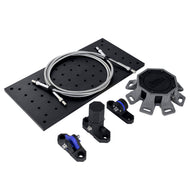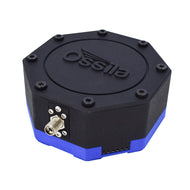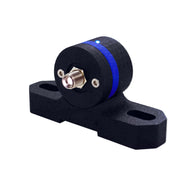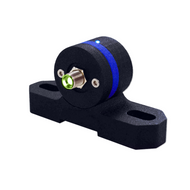Spectroscopy
Spectroscopy is the study of the interaction between a radiative energy and matter. This can refer to a range of different techniques, including:
- UV-vis or optical spectroscopy
- Fluorescence spectroscopy
- Raman spectroscopy
- Mass spectroscopy
Radiative energy is recorded using a spectrometer, or a detector within a spectrofluorometer, after it interacts with or is emitted by the sample material. The information is presented as a spectrum, showing intensity of the radiation as a function of energy, frequency, or wavelength. This can reveal important material properties, including physical or chemical structure, composition, and concentration.
The most widely studied type of radiative energy is optical spectroscopy, which studies material interaction with light within the UV, visible, and IR regions (often between 200-1000 nm). Depending on the experimental setup, spectroscopic techniques can measure absorption, transmission, reflectivity, photoluminescence and fluorescence, and more. At Ossila, we have a wide range of spectroscopy equipment to help you conduct a wide range of optical spectroscopy experiments.
Jump to: USB Spectroscopy Equipment | Resources | Technical Support


Monochromator
Coming Autumn 2025
Precise and reliable wavelength selection for your spectroscopy experiments.
The Ossila Monochromator is a compact and reliable instrument that can easily integrate into many optical setups. Choose a specific excitation wavelength for fluorescence measurements, isolate and measure specific emission signals, or simply improve the sensitivity and accuracy of absorbance measurements with just the touch of a button.
With free software, you can easily select specific wavelengths between 380 – 1000 nm with <1 nm accuracy and quickly measure across this spectral range with scanning rates of up to 1000 nm/s.
USB Spectroscopy Equipment
Compact and cost-effective, the Ossila USB Spectrometer integrates seamlessly into any lab setup. Compatible with a range of USB equipment and accessories, you can customize your optical spectroscopy setup to meet your specific research needs.
Browse all USB spectroscopy equipment
Resources
Buying Guides
Why Choose a Modular Spectrometer?
Spectrometers (or spectrophotometers) often come in large integrated systems with all components housed in one unit. These have high accuracies and are useful for taking repeat standard measurements – but they also have a large lab footprint and are expensive. These systems are useful for routine measurements, such as monitoring bacterial culture growth, checking sample purity or for very simple characterization of materials.
Read more... What is a Spectrometer? Types and Uses
What is a Spectrometer? Types and Uses
A spectrometer is a device that measures a continuous, non-discrete physical characteristic by first separating it into a spectrum of its constituent components.
Read more...Applications
Spectrometers can be designed and built using a number of different optical configurations. Careful choice of components and configuration can avoid aberrations, which result in distorted or blurred spectra.
Read more... UV-Vis Spectroscopy Troubleshooting
UV-Vis Spectroscopy Troubleshooting
It can be incredibly frustrating if you encounter a problem while performing UV-Vis spectroscopy, and usually causes an unnecessary delay.
Read more...Theory and Techniques
 Absorption Spectroscopy
Absorption Spectroscopy
In absorption spectroscopy, the intensity of light absorbed by a sample is measured as a function of wavelength. This can provide important information about the electronic structure of an atom or molecule.
Read more...Photoluminescence is luminescence resulting from photoexcitation. In other words, photoluminescence is when a material emits light following the absorption of energy from incident light from another light source.
Read more...Technical Support


















